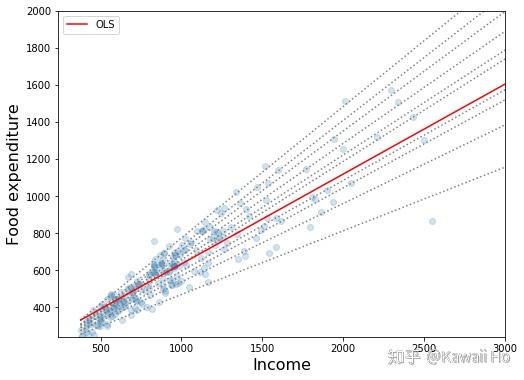分位数回归及其Python源码
分位数回归及其Python源码

天朗气清,惠风和畅。赋闲在家,正宜读书。前人文章,不得其解。代码开源,无人注释。你们不来,我行我上。废话少说,直入主题。o( ̄︶ ̄)o
我们要探测自变量 与因变量
的关系,最简单的方法是线性回归,即假设:
我们通过最小二乘方法 (OLS: ordinary least squares), 的可靠性问题,我们同时对残差
做了假设,即:
为均值为0,方差恒定的独立随机变量。
即为给定自变量
下,因变量
的条件均值。
假如残差 不满足我们的假设,或者更重要地,我们不仅仅想要知道
的在给定
下的条件均值,而且想知道是条件中位数(更一般地,条件分位数),那么OLS下的线性回归就不能满足我们的需求。分位数回归(Quantile Regression)[2]解决了这些问题,下面我先给出一个分位数回归的实际应用例子,再简述其原理,最后再分析其在Python实现的源代码。
1. 一个例子:收入与食品消费
这个例子出自statasmodels:Quantile Regression.[3] 我们想探索家庭收入与食品消费的关系,数据出自working class Belgian households in 1857 (the Engel data).我们用Python包statsmodels实现分位数回归。
1.1 预处理
%matplotlib inline
import numpy as np
import pandas as pd
import statsmodels.api as sm
import statsmodels.formula.api as smf
import matplotlib.pyplot as plt
data = sm.datasets.engel.load_pandas().data
data.head()
income foodexp
0 420.157651 255.839425
1 541.411707 310.958667
2 901.157457 485.680014
3 639.080229 402.997356
4 750.875606 495.560775
1.2 中位数回归 (分位数回归的特例,q=0.5)
mod = smf.quantreg('foodexp ~ income', data)
res = mod.fit(q=.5)
print(res.summary())
QuantReg Regression Results
==============================================================================
Dep. Variable: foodexp Pseudo R-squared: 0.6206
Model: QuantReg Bandwidth: 64.51
Method: Least Squares Sparsity: 209.3
Date: Mon, 21 Oct 2019 No. Observations: 235
Time: 17:46:59 Df Residuals: 233
Df Model: 1
==============================================================================
coef std err t P>|t| [0.025 0.975]
------------------------------------------------------------------------------
Intercept 81.4823 14.634 5.568 0.000 52.649 110.315
income 0.5602 0.013 42.516 0.000 0.534 0.586
==============================================================================
The condition number is large, 2.38e+03. This might indicate that there are
strong multicollinearity or other numerical problems.
由结果可以知道 ,如何得到回归系数的估计?结果中的std err, t, Pseudo R-squared等是什么?我会在稍后解释。
1.3 数据可视化
我们先拟合10个分位数回归,分位数q分别在0.05到0.95之间。
quantiles = np.arange(.05, .96, .1)
def fit_model(q):
res = mod.fit(q=q)
return [q, res.params['Intercept'], res.params['income']] + \
res.conf_int().loc['income'].tolist()
models = [fit_model(x) for x in quantiles]
models = pd.DataFrame(models, columns=['q', 'a', 'b', 'lb', 'ub'])
ols = smf.ols('foodexp ~ income', data).fit()
ols_ci = ols.conf_int().loc['income'].tolist()
ols = dict(a = ols.params['Intercept'],
b = ols.params['income'],
lb = ols_ci[0],
ub = ols_ci[1])
print(models)
print(ols)
q a b lb ub
0 0.05 124.880096 0.343361 0.268632 0.418090
1 0.15 111.693660 0.423708 0.382780 0.464636
2 0.25 95.483539 0.474103 0.439900 0.508306
3 0.35 105.841294 0.488901 0.457759 0.520043
4 0.45 81.083647 0.552428 0.525021 0.579835
5 0.55 89.661370 0.565601 0.540955 0.590247
6 0.65 74.033435 0.604576 0.582169 0.626982
7 0.75 62.396584 0.644014 0.622411 0.665617
8 0.85 52.272216 0.677603 0.657383 0.697823
9 0.95 64.103964 0.709069 0.687831 0.730306
{'a': 147.47538852370562, 'b': 0.48517842367692354, 'lb': 0.4568738130184233,
这里拟合了10个回归,其中q是对应的分位数,a是斜率,b是回归系数。lb和ub分别是b的95%置信区间的下界与上界。
现在来画出这10条回归线:
x = np.arange(data.income.min(), data.income.max(), 50)
get_y = lambda a, b: a + b * x
fig, ax = plt.subplots(figsize=(8, 6))
for i in range(models.shape[0]):
y = get_y(models.a[i], models.b[i])
ax.plot(x, y, linestyle='dotted', color='grey')
y = get_y(ols['a'], ols['b'])
ax.plot(x, y, color='red', label='OLS')
ax.scatter(data.income, data.foodexp, alpha=.2)
ax.set_xlim((240, 3000))
ax.set_ylim((240, 2000))
legend = ax.legend()
ax.set_xlabel('Income', fontsize=16)
ax.set_ylabel('Food expenditure', fontsize=16);

上图中虚线是分位数回归线,红线是线性最小二乘(OLS)的回归线。通过观察,我们可以发现3个现象:
- 随着收入提高,食品消费也在提高。
- 随着收入提高,家庭间食品消费的差别拉大。穷人别无选择,富人能选择生活方式,有喜欢吃贵的,也有喜欢吃便宜的。然而我们无法通过OLS发现这个现象,因为它只给了我们一个均值。
- 对与穷人来说,OLS预测值过高。这是因为少数的富人拉高了整体的均值,可见OLS对异常点敏感,不是一个稳健的模型。
2.分位数回归的原理
这部分是数理统计的内容,只关心如何实现的朋友可以略过。我们要解决以下这几个问题:
- 什么是分位数?
- 如何求分位数?
- 什么是分位数回归?
- 分位数回归的回归系数如何求得?
- 回归系数的检验如何进行?
- 如何评估回归拟合优度?
2.1 分位数的定义]
是随机变量,
的累积密度函数是
.
的
分位数为:
,
假设有100个人,95%的人身高少于1.9m, 1.9m就是身高的95%分位数。
2.2 分位数的求法
通过选择不同的 值,使
最小,对应的
值即为
的
分位数的估计
.
2.3 分位数回归
对于OLS, 我们有:
为
最小化所对应的
,类比地,对于
分位数回归,我们有:
为最小化:
即最小化
所对应的
2.4 系数估计
由于 不能直接对
求导,我们只能用迭代的方法来逼近
最小时对应的
值。statsmodels采用了Iteratively reweighted least squares (IRLS)的方法。
假设我们要求 最小化形如下的
范数:
则第t+1步迭代的 值为:
是对角矩阵且初始值为
第t次迭代
以中位数回归为例子(q=0.5),我们求:
即
即最小化形如上的 范数,
为避免分母为0,我们取 ,
是一个很小的数,例如0.0001.
2.5 回归系数的检验
我们通过2.4,多次迭代得出 的估计值,为了得到假设检验的t统计量,我们只需得到
的方差的估计。
分位数回归
的协方差矩阵的渐近估计为:
其中 是对角矩阵,
当 ,
, 当
,
的估计为
其中
为核函数(Kernel),可取Epa,Gaussian等.
为根据Stata 12所选的窗宽(bandwidth)[5]
回归结果中的std err即由 获得,t统计量等于
。
2.6 拟合优度
对于OLS,我们用 来衡量拟合优度。对于
分位数回归,我们类比得到:
,其中
为所有
观察值的
分位数。
即为回归结果中的Pseudo R-squared。
3.Python源码分析
实现分位数回归的完整源码在 ,里面主要含有两个类QuantReg 和 QuantRegResults. 其中QuantReg是核心,包含了回归系数估计,协方差计算等过程。QuantRegResults计算拟合优度并组织回归结果。
3.1 QuantReg类
#QuantReg是包中RegressionModel的一个子类
class QuantReg(RegressionModel):
#计算回归系数及其协方差矩阵。q是分位数,vcov是协方差矩阵,默认robust即2.5的方法。核函数kernel默认
#epa,窗宽bandwidth默认hsheather.IRLS最大迭代次数默认1000,差值默认小于1e-6时停止迭代
def fit(self, q=.5, vcov='robust', kernel='epa', bandwidth='hsheather',
max_iter=1000, p_tol=1e-6, **kwargs):
"""
Solve by Iterative Weighted Least Squares
Parameters
----------
q : float
Quantile must be between 0 and 1
vcov : str, method used to calculate the variance-covariance matrix
of the parameters. Default is ``robust``:
- robust : heteroskedasticity robust standard errors (as suggested
in Greene 6th edition)
- iid : iid errors (as in Stata 12)
kernel : str, kernel to use in the kernel density estimation for the
asymptotic covariance matrix:
- epa: Epanechnikov
- cos: Cosine
- gau: Gaussian
- par: Parzene
bandwidth : str, Bandwidth selection method in kernel density
estimation for asymptotic covariance estimate (full
references in QuantReg docstring):
- hsheather: Hall-Sheather (1988)
- bofinger: Bofinger (1975)
- chamberlain: Chamberlain (1994)
"""
if q < 0 or q > 1:
raise Exception('p must be between 0 and 1')
kern_names = ['biw', 'cos', 'epa', 'gau', 'par']
if kernel not in kern_names:
raise Exception("kernel must be one of " + ', '.join(kern_names))
else:
kernel = kernels[kernel]
if bandwidth == 'hsheather':
bandwidth = hall_sheather
elif bandwidth == 'bofinger':
bandwidth = bofinger
elif bandwidth == 'chamberlain':
bandwidth = chamberlain
else:
raise Exception("bandwidth must be in 'hsheather', 'bofinger', 'chamberlain'")
#endog样本因变量,exog样本自变量
endog = self.endog
exog = self.exog
nobs = self.nobs
exog_rank = np.linalg.matrix_rank(self.exog)
self.rank = exog_rank
self.df_model = float(self.rank - self.k_constant)
self.df_resid = self.nobs - self.rank
#IRLS初始化
n_iter = 0
xstar = exog
beta = np.ones(exog_rank)
# TODO: better start, initial beta is used only for convergence check
# Note the following does not work yet,
# the iteration loop always starts with OLS as initial beta
# if start_params is not None:
# if len(start_params) != rank:
# raise ValueError('start_params has wrong length')
# beta = start_params
# else:
# # start with OLS
# beta = np.dot(np.linalg.pinv(exog), endog)
diff = 10
cycle = False
history = dict(params = [], mse=[])
#IRLS迭代
while n_iter < max_iter and diff > p_tol and not cycle:
n_iter += 1
beta0 = beta
xtx = np.dot(xstar.T, exog)
xty = np.dot(xstar.T, endog)
beta = np.dot(pinv(xtx), xty)
resid = endog - np.dot(exog, beta)
mask = np.abs(resid) < .000001
resid[mask] = ((resid[mask] >= 0) * 2 - 1) * .000001
resid = np.where(resid < 0, q * resid, (1-q) * resid)
resid = np.abs(resid)
#1/resid[:, np.newaxis]为更新权重W
xstar = exog / resid[:, np.newaxis]
diff = np.max(np.abs(beta - beta0))
history['params'].append(beta)
history['mse'].append(np.mean(resid*resid))
#检查是否收敛,若收敛则提前停止迭代
if (n_iter >= 300) and (n_iter % 100 == 0):
# check for convergence circle, should not happen
for ii in range(2, 10):
if np.all(beta == history['params'][-ii]):
cycle = True
warnings.warn("Convergence cycle detected", ConvergenceWarning)
break
if n_iter == max_iter:
warnings.warn("Maximum number of iterations (" + str(max_iter) +
") reached.", IterationLimitWarning)
#计算协方差矩阵
e = endog - np.dot(exog, beta)
# Greene (2008, p.407) writes that Stata 6 uses this bandwidth:
# h = 0.9 * np.std(e) / (nobs**0.2)
# Instead, we calculate bandwidth as in Stata 12
iqre = stats.scoreatpercentile(e, 75) - stats.scoreatpercentile(e, 25)
h = bandwidth(nobs, q)
h = min(np.std(endog),
iqre / 1.34) * (norm.ppf(q + h) - norm.ppf(q - h))
fhat0 = 1. / (nobs * h) * np.sum(kernel(e / h))
if vcov == 'robust':
d = np.where(e > 0, (q/fhat0)**2, ((1-q)/fhat0)**2)
xtxi = pinv(np.dot(exog.T, exog))
xtdx = np.dot(exog.T * d[np.newaxis, :], exog)
vcov = chain_dot(xtxi, xtdx, xtxi)
elif vcov == 'iid':
vcov = (1. / fhat0)**2 * q * (1 - q) * pinv(np.dot(exog.T, exog))
else:
raise Exception("vcov must be 'robust' or 'iid'")
#用系数估计值和协方差矩阵创建一个QuantResults对象,并输出结果
lfit = QuantRegResults(self, beta, normalized_cov_params=vcov)
lfit.q = q
lfit.iterations = n_iter
lfit.sparsity = 1. / fhat0
lfit.bandwidth = h
lfit.history = history
return RegressionResultsWrapper(lfit)
#核函数表达式
def _parzen(u):
z = np.where(np.abs(u) <= .5, 4./3 - 8. * u**2 + 8. * np.abs(u)**3,
8. * (1 - np.abs(u))**3 / 3.)
z[np.abs(u) > 1] = 0
return z
kernels = {}
kernels['biw'] = lambda u: 15. / 16 * (1 - u**2)**2 * np.where(np.abs(u) <= 1, 1, 0)
kernels['cos'] = lambda u: np.where(np.abs(u) <= .5, 1 + np.cos(2 * np.pi * u), 0)
kernels['epa'] = lambda u: 3. / 4 * (1-u**2) * np.where(np.abs(u) <= 1, 1, 0)
kernels['gau'] = lambda u: norm.pdf(u)
kernels['par'] = _parzen
#kernels['bet'] = lambda u: np.where(np.abs(u) <= 1, .75 * (1 - u) * (1 + u), 0)
#kernels['log'] = lambda u: logistic.pdf(u) * (1 - logistic.pdf(u))
#kernels['tri'] = lambda u: np.where(np.abs(u) <= 1, 1 - np.abs(u), 0)
#kernels['trw'] = lambda u: 35. / 32 * (1 - u**2)**3 * np.where(np.abs(u) <= 1, 1, 0)
#kernels['uni'] = lambda u: 1. / 2 * np.where(np.abs(u) <= 1, 1, 0)
#窗宽计算
def hall_sheather(n, q, alpha=.05):
z = norm.ppf(q)
num = 1.5 * norm.pdf(z)**2.
den = 2. * z**2. + 1.
h = n**(-1. / 3) * norm.ppf(1. - alpha / 2.)**(2./3) * (num / den)**(1./3)
return h
def bofinger(n, q):
num = 9. / 2 * norm.pdf(2 * norm.ppf(q))**4
den = (2 * norm.ppf(q)**2 + 1)**2
h = n**(-1. / 5) * (num / den)**(1. / 5)
return h
def chamberlain(n, q, alpha=.05):
return norm.ppf(1 - alpha / 2) * np.sqrt(q*(1 - q) / n)
3.2 QuantRegResults类
这里我只给出计算拟合优度的代码。
class QuantRegResults(RegressionResults):
'''Results instance for the QuantReg model'''
@cache_readonly
def prsquared(self):
q = self.q
endog = self.model.endog
#e为残差
e = self.resid
e = np.where(e < 0, (1 - q) * e, q * e)
e = np.abs(e)
ered = endog - stats.scoreatpercentile(endog, q * 100)
ered = np.where(ered < 0, (1 - q) * ered, q * ered)
ered = np.abs(ered)
return 1 - np.sum(e) / np.sum(ered)
4.总结
上文我先给出了一个分位数回归的应用例子,进而叙述了分位数回归的原理,最后再分析了Python实现的源码。
分位数回归对比起OLS回归,虽然较为复杂,但它有三个主要优势:
- 能反映因变量分位数与自变量的关系,而不仅仅反映因变量均值与自变量的关系。
- 分位数回归对残差不作任何假设。
- 分位数回归受异常点的影响较小。
参考
- ^https://en.wikipedia.org/wiki/Ordinary_least_squares
- ^QUANTILE REGRESSION http://www.econ.uiuc.edu/~roger/research/rq/rq.pdf
- ^https://www.statsmodels.org/dev/examples/notebooks/generated/quantile_regression.html
- [1](https://www.zhihu.com/#ref_4_0)bchttps://en.wikipedia.org/wiki/Quantile_regression
- [2](https://www.zhihu.com/#ref_5_0)bchttps://www.statsmodels.org/devel/_modules/statsmodels/regression/quantile_regression.html
- ^https://en.wikipedia.org/wiki/Iteratively_reweighted_least_squares
- ^Green,W. H. (2008). Econometric Analysis. Sixth Edition. International Student Edition.
- ^https://www.ibm.com/support/knowledgecenter/en/SSLVMB_sub/statistics_mainhelp_ddita/spss/regression/idh_quantile.html
分位数回归及其Python源码的更多相关文章
- 读python源码--对象模型
学python的人都知道,python中一切皆是对象,如class生成的对象是对象,class本身也是对象,int是对象,str是对象,dict是对象....所以,我很好奇,python是怎样实现这些 ...
- VS2013编译python源码
系统:win10 手头有个python模块,是用C写的,想编译安装就需要让python调用C编译器.直接编译发现使用的是vc9编译,不支持C99标准(两个槽点:为啥VS2008都还不支持C99?手头这 ...
- 三种排序算法python源码——冒泡排序、插入排序、选择排序
最近在学习python,用python实现几个简单的排序算法,一方面巩固一下数据结构的知识,另一方面加深一下python的简单语法. 冒泡排序算法的思路是对任意两个相邻的数据进行比较,每次将最小和最大 ...
- 《python源码剖析》笔记一——python编译
1.python的架构: 2.python源码的组织结构: 3.windows环境下编译python:
- 转换器5:参考Python源码,实现Php代码转Ast并直接运行
前两个周末写了<手写PHP转Python编译器>的词法,语法分析部分,上个周末卡文了. 访问器部分写了两次都不满意,没办法,只好停下来,参考一下Python的实现.我实现的部分正好和Pyt ...
- python源码书籍
<Python源码剖析>一书现在很难买到,目前大部分都是电子书. 为了更好地利用Python语言,无论是使用Python语言本身,还是将Python与C/C++交互使用,深刻理解Pytho ...
- 类似py2exe软件真的能保护python源码吗
类似py2exe软件真的能保护python源码吗 背景 最近写了个工具用于对项目中C/C++文件的字符串常量进行自动化加密处理,用python写的,工具效果不错,所以打算在公司内部推广.为了防止代码泄 ...
- Python源码中的PyCodeObject
1.Python程序的执行过程 Python解释器(interpreter)在执行任何一个Python程序文件时,首先进行的动作都是先对文件中的Python源代码进行编译,编译的主要结果是产生的一组P ...
- Python源码学习(一)
考虑到性能的要求,我在工作中用的最多的是c/c++,然而,工作中又经常会有一些验证性的工作,这些工作对性能的要求并不高,反而对完成的效率要求更高,对于这样的工作,用一种开发效率高的语言是合理的想法,鉴 ...
随机推荐
- Springboot 默认静态路径
springboot 默认静态路径 代码如下所示 类ResourceProperties.class private static final String[] CLASSPATH_RESOURCE_ ...
- sh_10_字典基本使用
sh_10_字典基本使用 xiaoming_dict = {"name": "小明"} # 1. 取值 print(xiaoming_dict["na ...
- vue的基础数据绑定
todo https://www.jb51.net/article/132344.htm
- 分布式-信息方式-ActiveMQ的静态网络连接
ActiveMQ的静态网络连接 在一台服务器上启动多个Broker步骤如下:1:把整个conf文件夹复制一份,比如叫做conf22:修改里面的 activ ...
- spring整合之后运行报什么只读错误。Write operations are not allowed in read-only mode (FlushMode.MANUAL): Turn your Session into FlushMode.COMMIT/AUTO or remove 'readOnly' marker from transaction definition.
解决办法, 再大dao的实现类上添加注解: @Transactional(readOnly = false ) 不让它只读就行了
- 【Spark机器学习速成宝典】基础篇01Windows下spark开发环境搭建+sbt+idea(Scala版)
注意: spark用2.1.1 scala用2.11.11 材料准备 spark安装包 JDK 8 IDEA开发工具 scala 2.11.8 (注:spark2.1.0环境于scala2.11环境开 ...
- var $this = $(this)
jQuery: What’s the Difference Between $(this), $this, and this? What about $this? $this is a little ...
- 深入理解android的UI更新机制
深入理解android的UI更新机制 由问题开始: 如何更新android UI? 可以通过如下方法: 在主线程里直接操作UI控件. handler.post(Runnable) runOnUiThr ...
- 1.2 Mac下配置maven环境变量
1.下载JDK http://www.oracle.com/technetwork/java/javase/downloads/jdk8-downloads-2133151.html 2.下载Mave ...
- 【剑指offer38】字符串的排列
如果没有要求字典序排序,则直接采用递归的思想,将字符串的排列看成两步,第一步,交换第一个字母和任意一个字母(包括自己,但不包括和自己相等的其他字母)固定第一个字母,固定第一个字母,然后对后面的字符串也 ...
